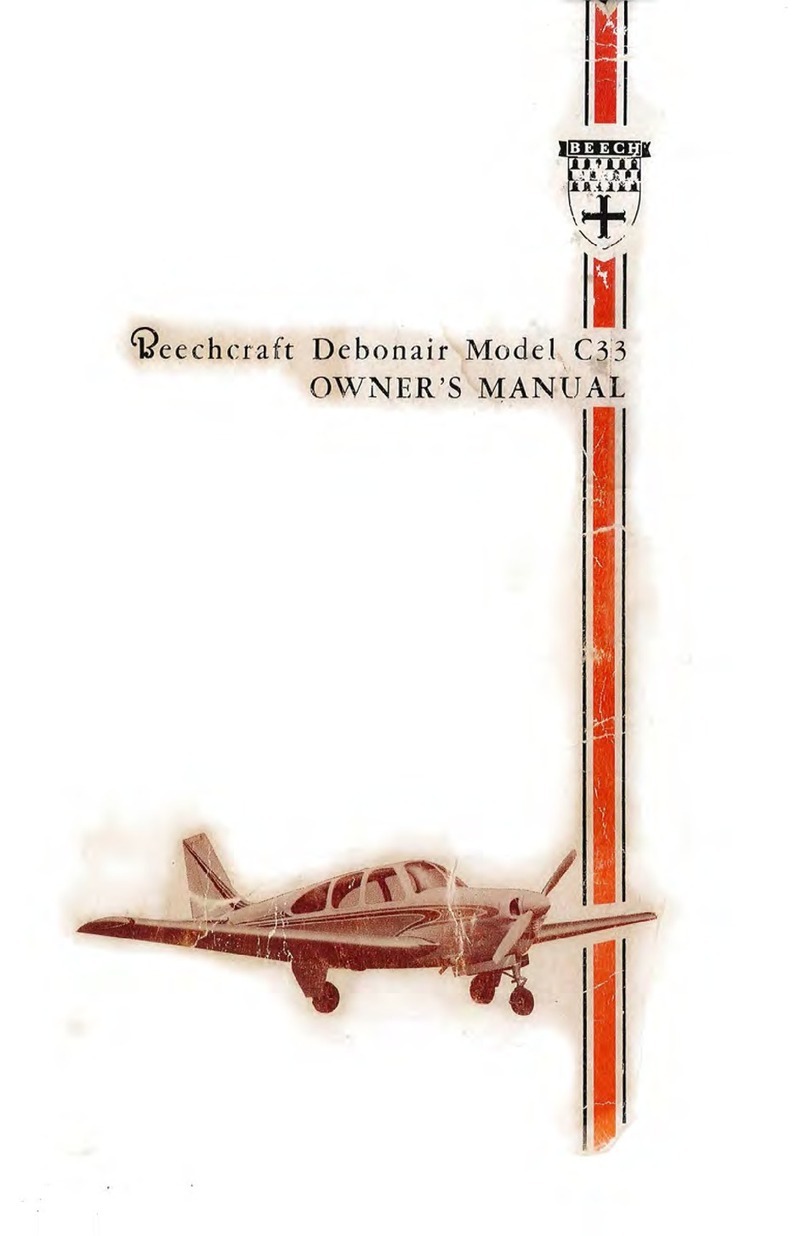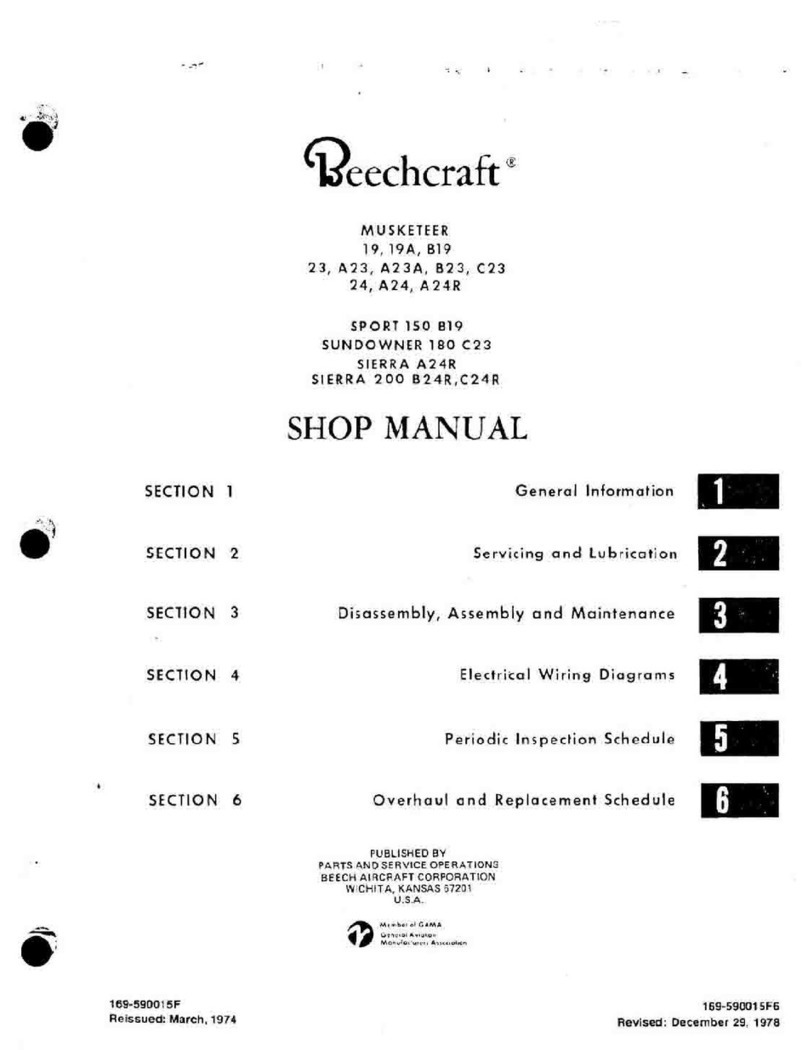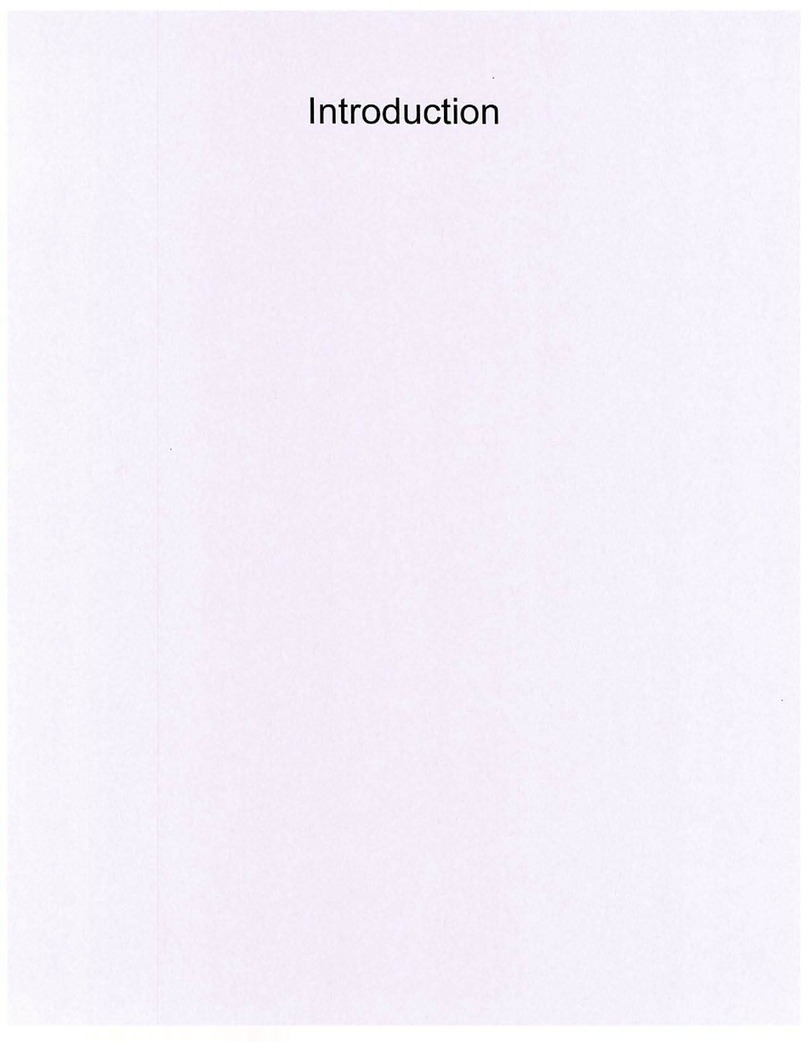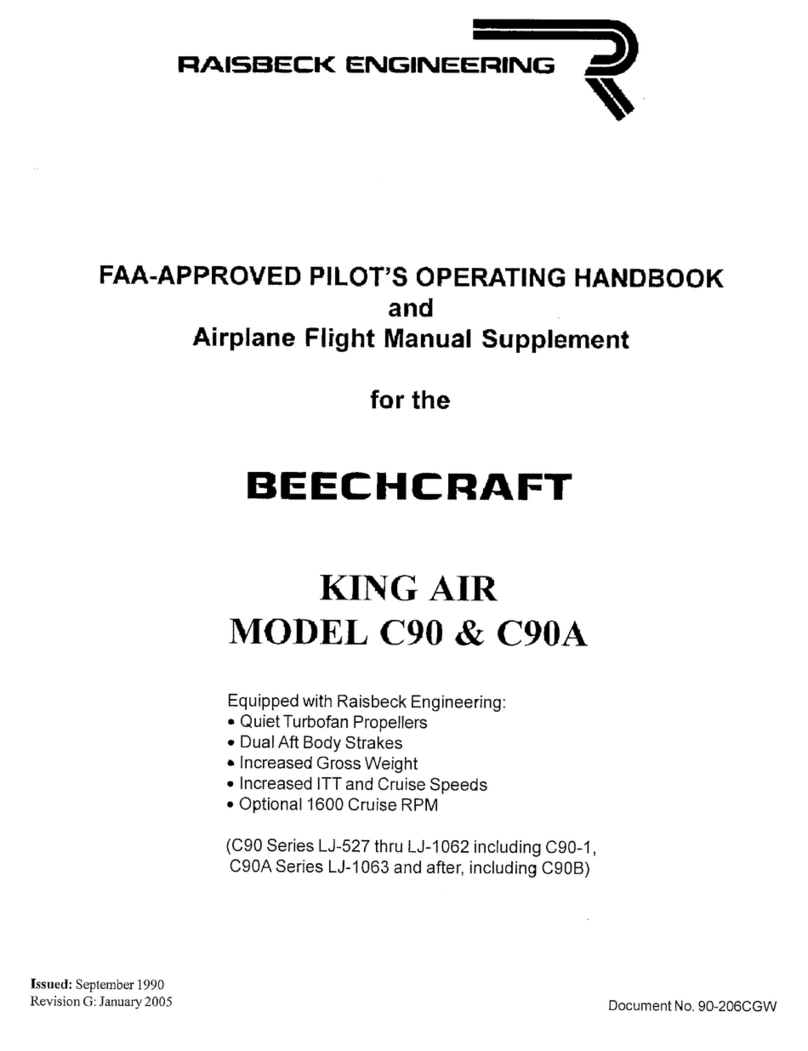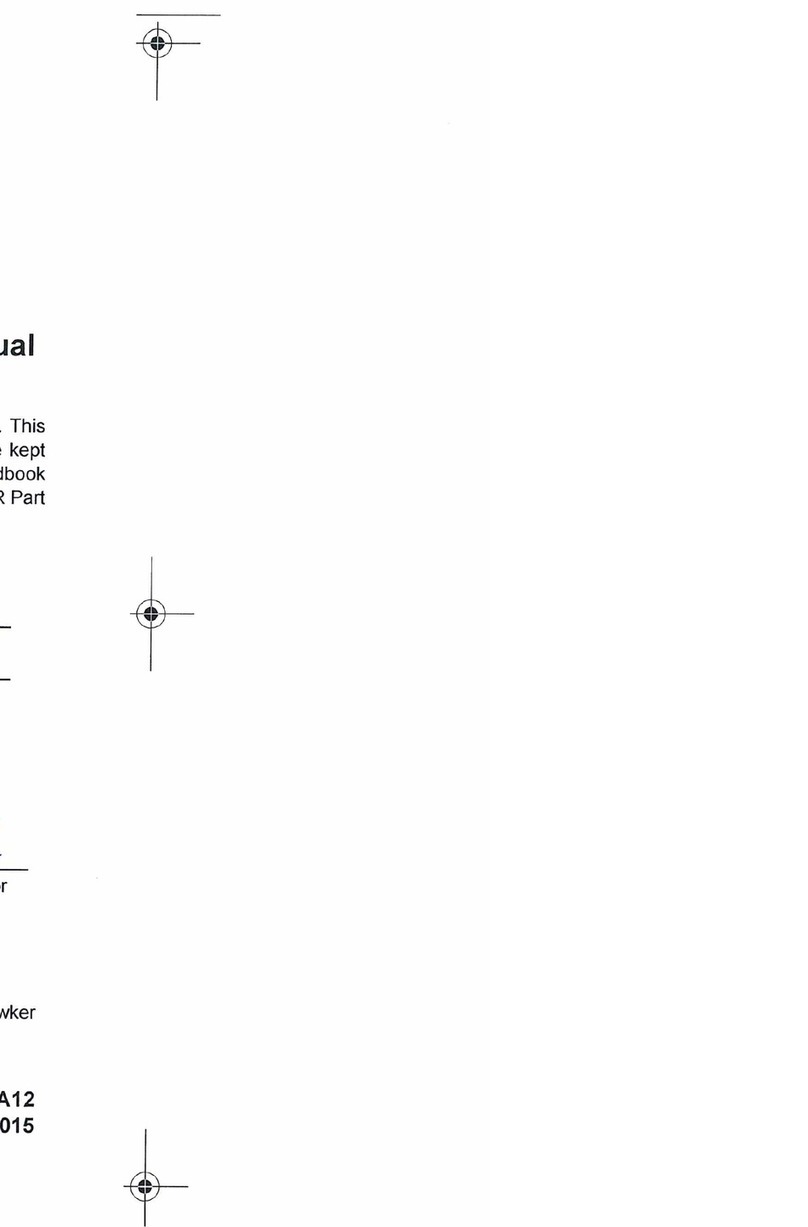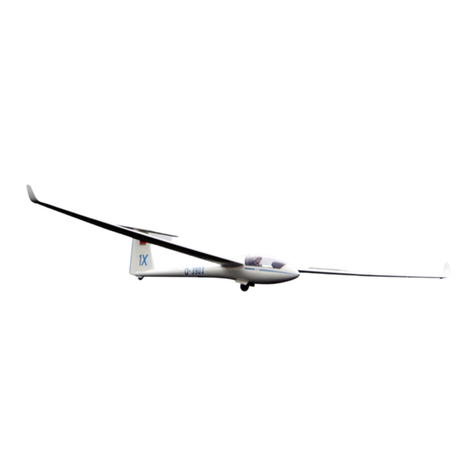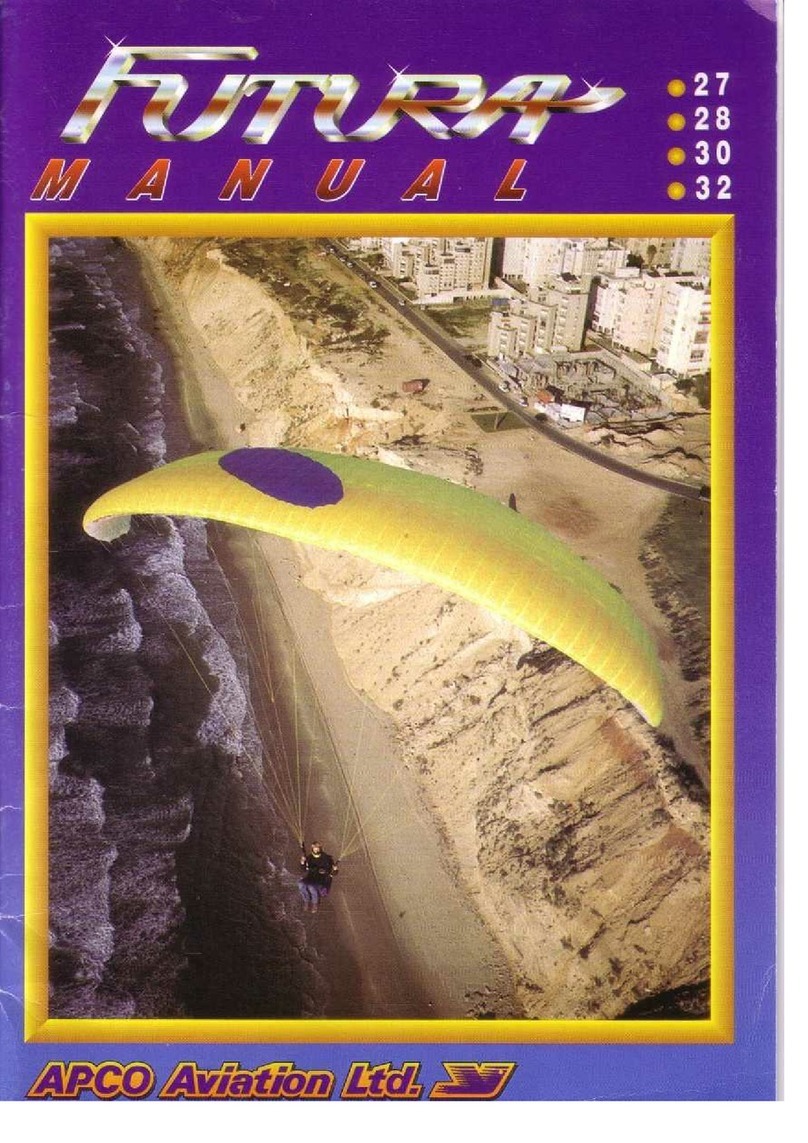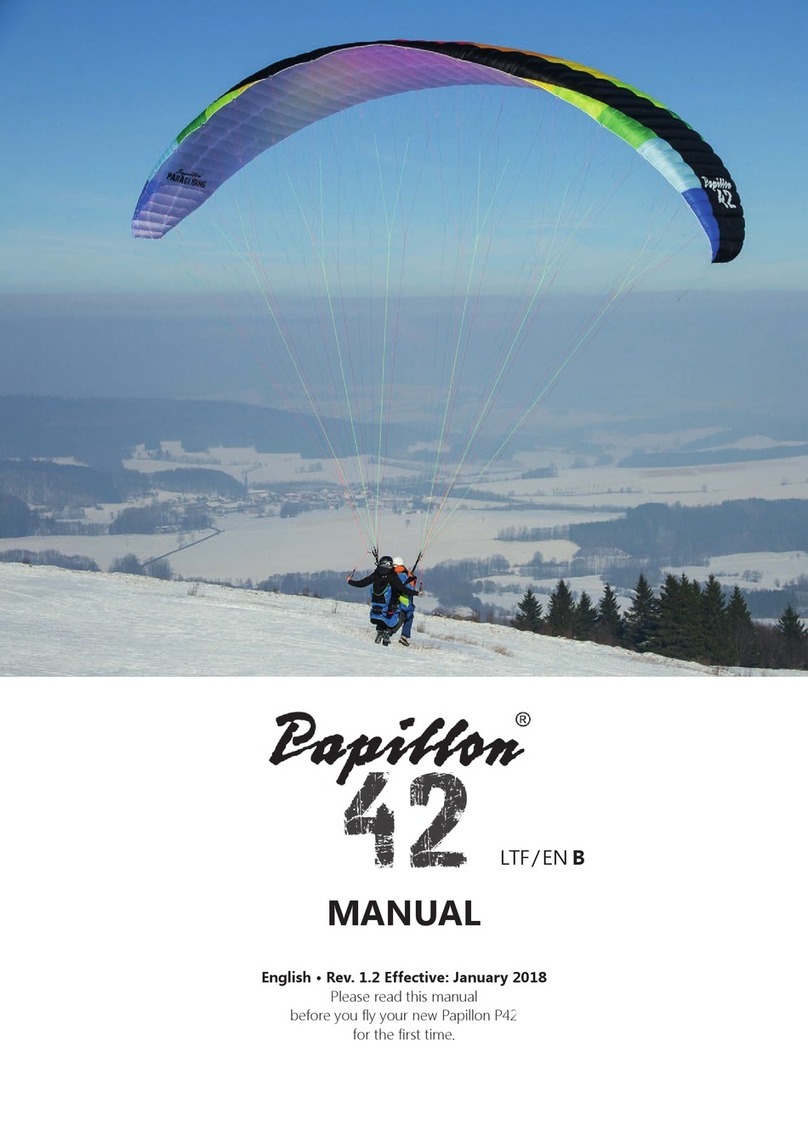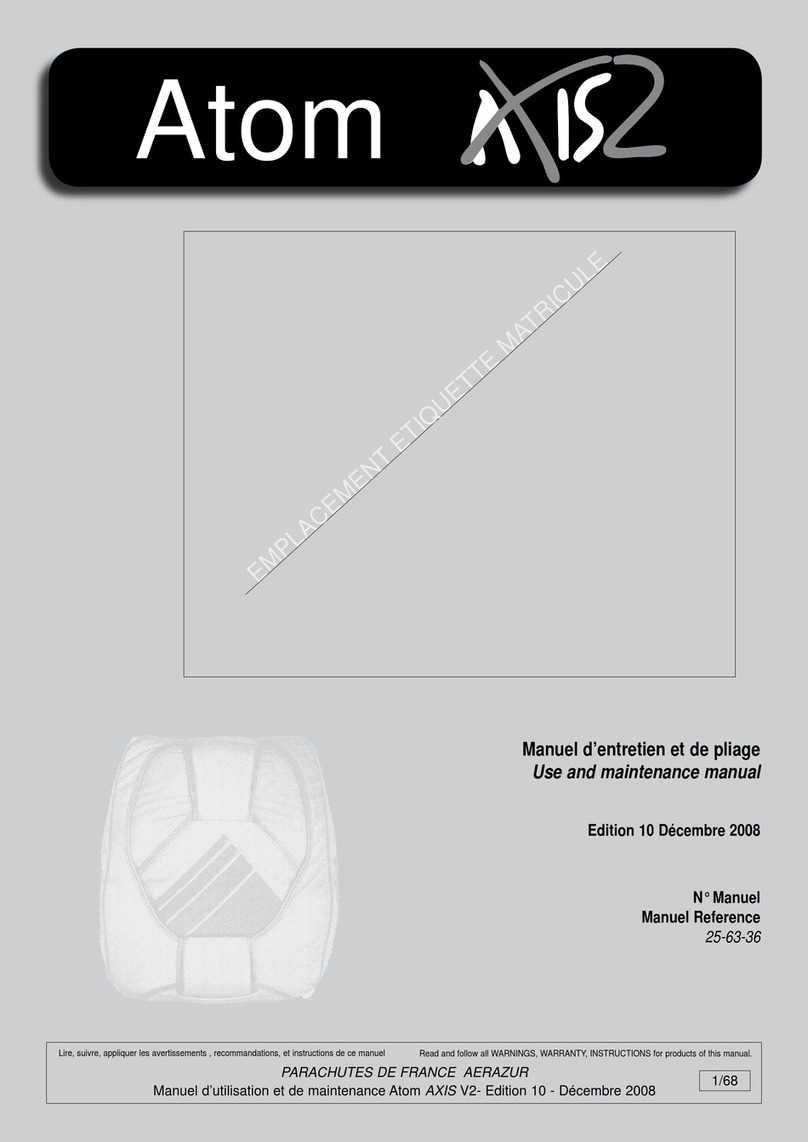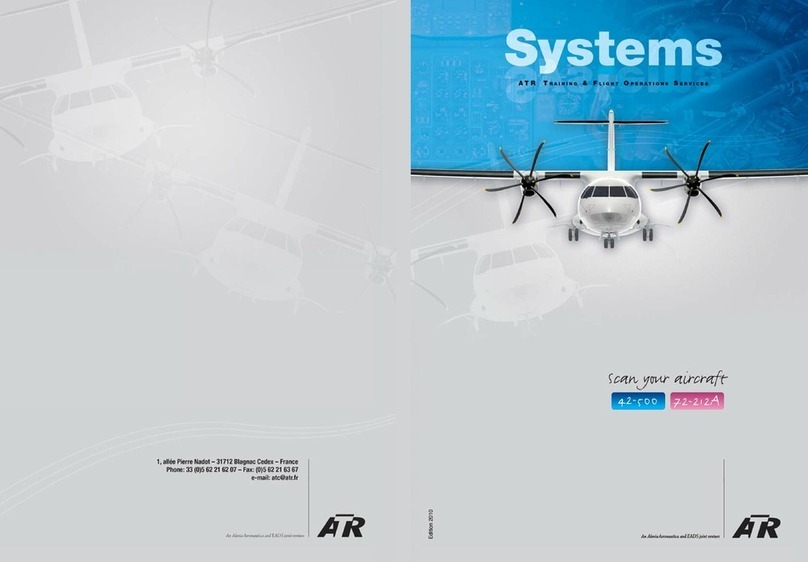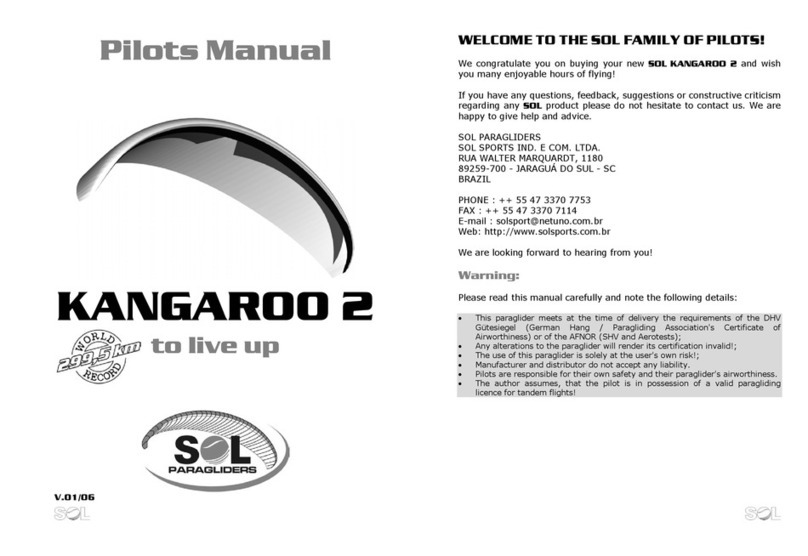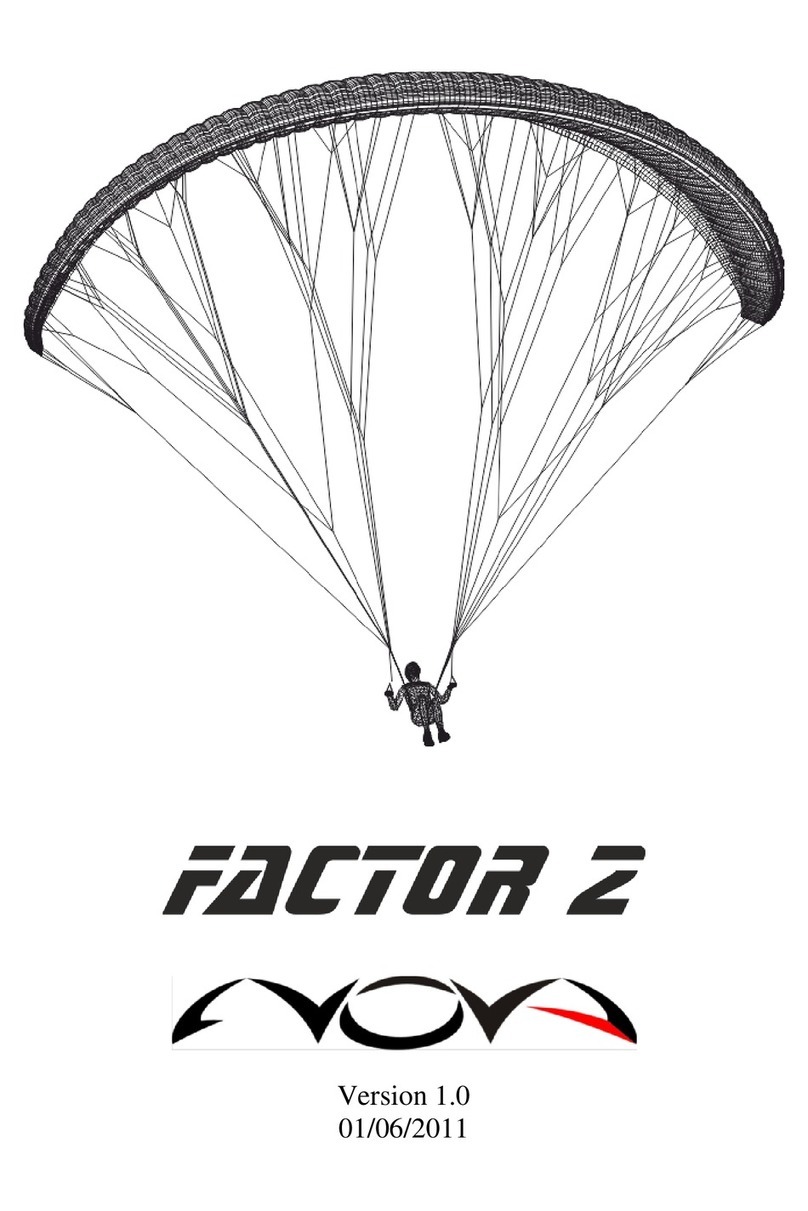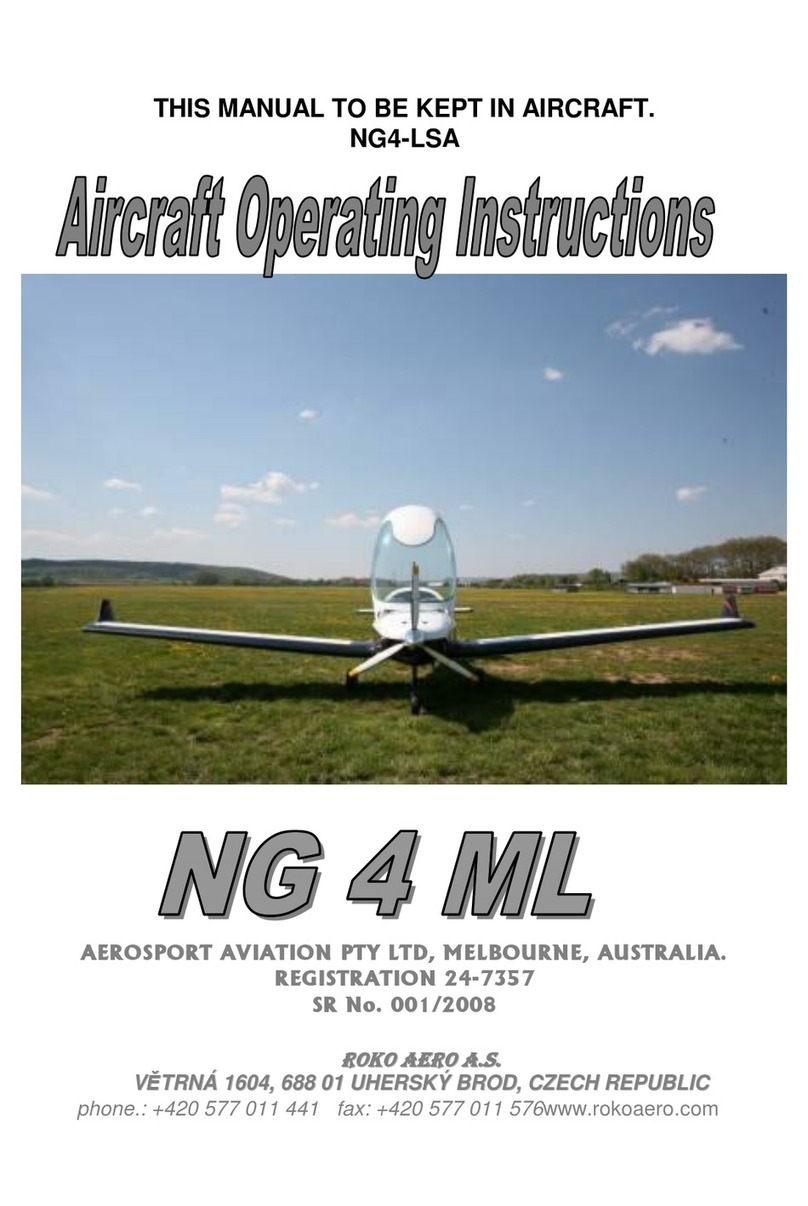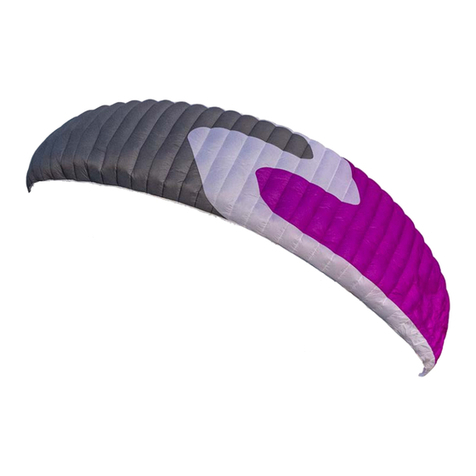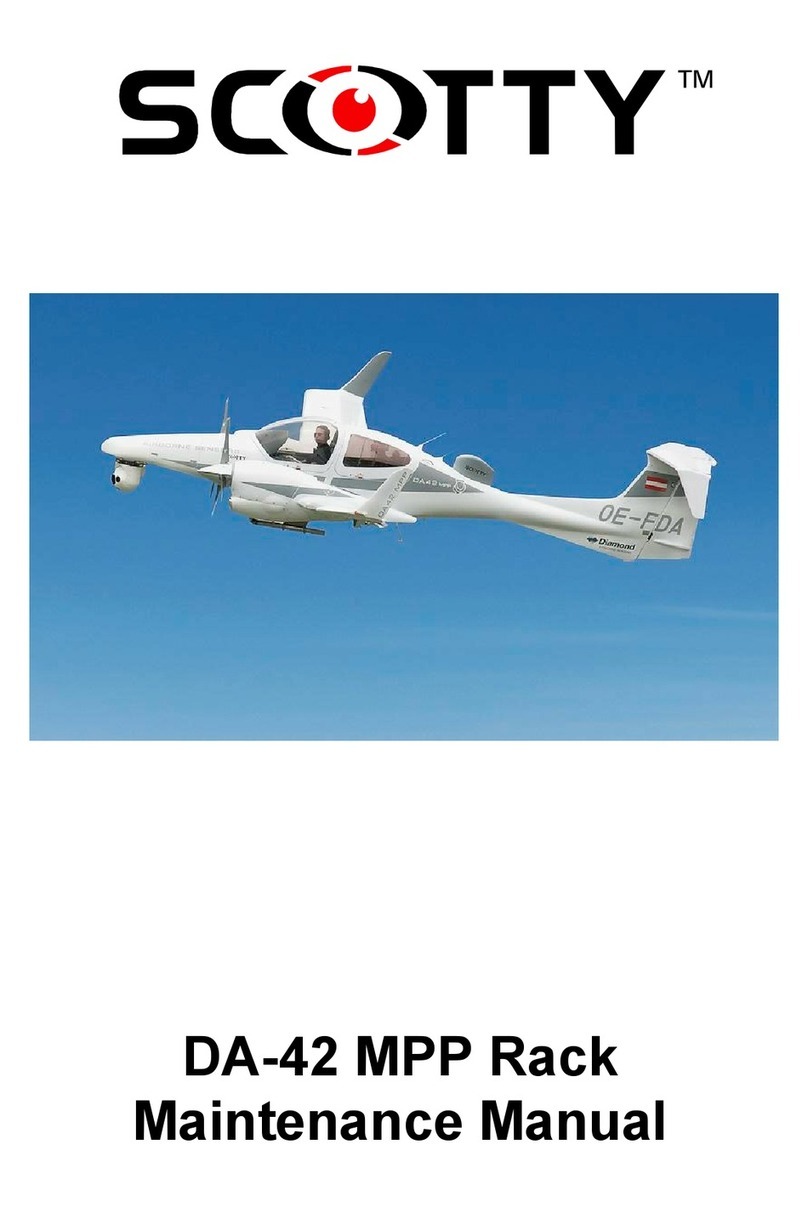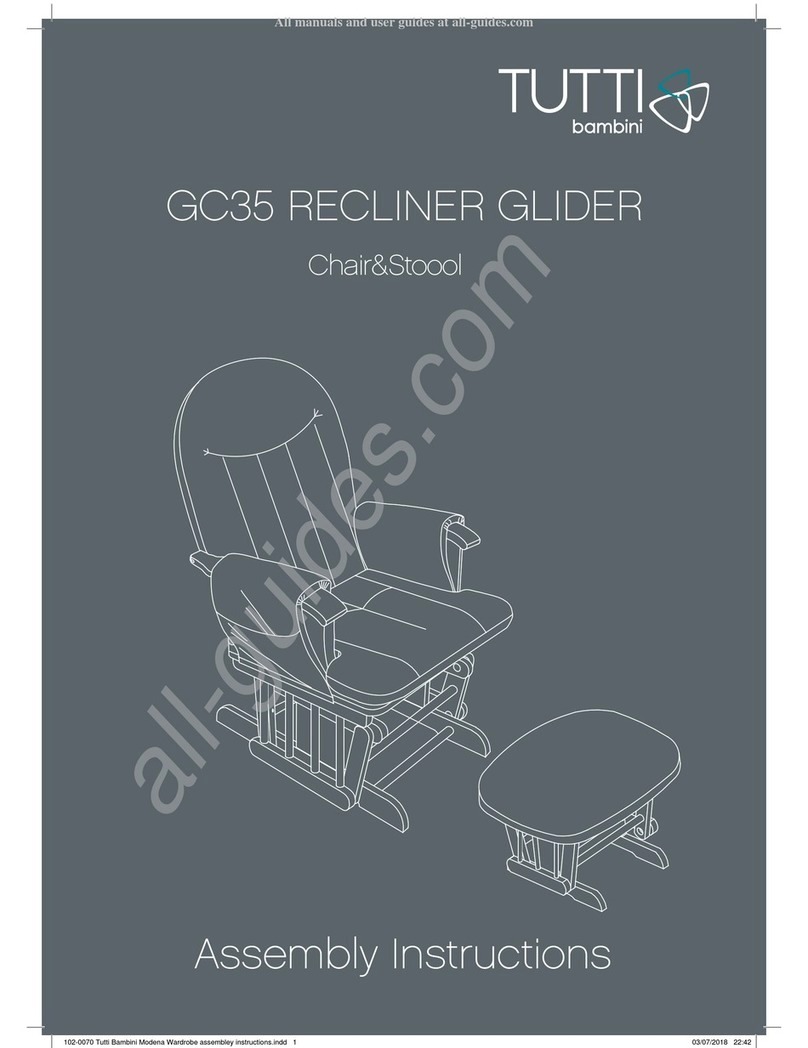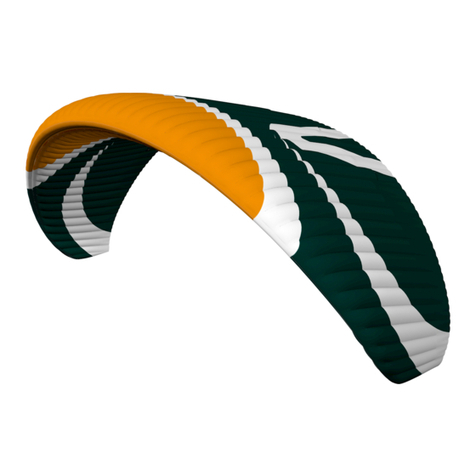Beechcraft C-12C Use and care manual

*TM 1-1510-218-10
TECHNICAL MANUAL
WARNING DATA
TABLE OF CONTENTS
INTRODUCTION
DESCRIPTION AND
OPERATION
AVIONICS
MISSION EQUIPMENT
OPERATING LIMITS AND
RE
S
TRI
C
TI
O
N
S
WEIGHT/BALANCE AND
L
O
ADIN
G
PERFORMANCE DATA
NORMAL PROCEDURES
EMERGENCY PROCEDURES
REFERENCES
ABBREVIATIONS AND
TERMS
ALPHABETICAL INDEX
OPERATOR'S MANUAL
FOR
ARMY C-12C AIRCRAFT
NSN 1510-01-070-3661
ARMY C-12D AIRCRAFT
NSN 1510-01-087-9129
ARMY C-12T AIRCRAFT
NSN 1510-01-470-0220
Distribution statement A: Approved for public
release, distribution is unlimited.
*This manual supersedes TM-1-1510-218-10 dated
4 September 2001.
HEADQUARTERS
DEPARTMENT OF THE ARMY
200


TM 1-1510-218-10
WARNING PAGE
Personnel performing operations, procedures, and practices that are included or implied in this
technical manual shall observe the following warnings. Disregard of these warnings and
precautionary information can cause serious injury or loss of life.
NOISE LEVELS
Sound pressure levels in this aircraft during some operating conditions exceed the Surgeon
General's hearing conservation criteria, as defined in TB MED 501. Hearing protection devices,
such as a headset or ear plugs, shall be worn by all personnel in and around the aircraft during its
operation.
STARTING ENGINES
Operating procedures or practices defined in this technical manual must be followed correctly.
Failure to do so may result in personal injury or loss of life.
Exposure to exhaust gases shall be avoided since exhaust gases are an irritant to eyes, skin, and
respiratory system.
HIGH VOLTAGE
High voltage is a potential hazard around AC inverters, ignition exciter units, and strobe beacons.
USE OF FIRE EXTINGUISHERS IN CONFINED AREAS
Monobromotrifluoromethane (CF3Br) is very volatile, but is not easily detected by its odor-
Although non toxic, it must be considered to be about the same as other refrigerants and carbon
dioxide, causing danger to personnel primarily by reduction of oxygen available for proper
breathing. During operation of the fire extinguisher, ventilate personnel areas with fresh air. The
liquid shall not be allowed to come into contact with the skin, as it may cause frostbite or low
temperature burns because of its very low boiling point
VERTIGO
The strobe beacon lights should be turned off during flight through clouds to prevent sensations
of vertigo, as a result of reflections of the light on the clouds.
a

TM 1-1510-218-10
CARBON MONOXIDE
When smoke, suspected carbon monoxide fumes, or symptoms of lack of oxygen (hypoxia) exist,
all personnel shall immediately don oxygen masks, and activate the oxygen system.
FUEL AND OIL HANDLING
Turbine fuels and lubricating oils contain additives that are poisonous and readily absorbed
through the skin. Do not allow them to remain on skin.
SERVICING AIRCRAFT
When conditions permit, the aircraft shall be positioned so that the wind will carry fuel vapors
away from all possible sources of ignition. The fueling unit shall maintain a distance of 20 feet
between unit and filler point. A minimum of 10 feet shall be maintained between fueling unit and
aircraft. Prior to refueling, the hose nozzle static ground wire shall be attached to the grounding
lugs.
SERVICING BATTERY
Improper service of the nickel-cadmium battery is dangerous and may result in both bodily injury
and equipment damage. The battery shall be serviced in accordance with applicable manuals by
qualified personnel only.
Battery electrolyte (potassium hydroxide) is corrosive. Wear rubber gloves, apron, and face
shield when handling batteries. If potassium hydroxide is spilled on clothing, or other material,
wash immediately with clean water. If spilled on personnel, immediately start flushing the
affected area with clean water. Continue washing until medical assistance arrives.
JET BLAST
Occasionally, during starting, excess fuel accumulation in the combustion chamber causes
flames to be blown from the exhausts. This area shall be clear of personnel and flammable
materials.
RADIOACTIVE MATERIAL
Instruments contained in this aircraft may contain radioactive material (TB 55-1510-314-25). These
items present no radiation hazard to personnel unless seal has been broken due to aging or has
accidentally been broken. If seal is suspected to have been broken, notify Radioactive Protective
Officer.
RF BURNS
Do not stand near the antennas when they are transmitting.
b

TM 1-1510-218-10
c/(d blank)
OPERATION OF AIRCRAFT ON GROUND
Engines shall be started and operated only by authorized personnel. Reference AR 95-1. LCCS
contractor personnel are authorized IAW the Contract and Statement of Work. Ensure that landing
gear control handle is in the DN position.


TM 1-1510-218-10
INSERT LATEST CHANGE PAGES. DESTROY SUPERSEDED PAGES.
NOTE: The portion of the text affected by the changes is
indicated by a vertical line in the outer margins of the
page. Changes to illustrations are indicated by
miniature pointing hands. Changes to wiring
diagrams are indicated by shaded areas.
Dates of issue for original and change pages are:
Original . . . . . 0 . . . . . 1 October 2009
TOTAL NUMBER OF PAGES IN THIS PUBLICATION IS 943, CONSISTING OF THE
FOLLOWING:
Page *Change Page *Change
No. No. No. No.
Title 0 9-1 –9-19 0
a –c 0 9-20 Blank 0
d Blank 0 A-1 0
A 0 A-2 Blank 0
B Blank 0 B-1 –B-9 0
i –iii 0 B-10 Blank 0
iv Blank 0 Index-1 –Index-16 0
1-1 –1-3 0
1-4 blank 0
2-1 –2-137 0
2-138 Blank 0
3-1 –3-88 0
3A-1 –3A-47 0
3A-48 Blank 0
3B-1 –3B-64 0
3C-1 –3C-119 0
3C-220 Blank 0
4-1 0
4-2 Blank 0
5-1 –5-18 0
6-1 –6-17 0
6-18 Blank 0
7-1 –7-90 0
7A-1 – 7A-123 0
7A-124 Blank 0
8-1 –8-34 0
8A-1 –8A-30 0
LIST OF EFFECTIVE PAGES
$%EODQN


*TM 1-1510-218-10
TECHNICAL MANUAL HEADQUARTERS
DEPARTMENT OF THE ARMY
NO. 1-1510-218-10 WASHINGTON, DC,1 OCTOBER 2009
OPERATOR'S MANUAL FOR
ARMY C-12C, C-12D, C-12T1, AND C-12T2 AIRCRAFT
REPORTING OF ERRORS AND RECOMMENDING IMPROVEMENTS
You can help improve this manual. If you find any mistakes or if you know of a way to
improve the procedures, please let us know. Mail your letter, DA Form 2028
(Recommended Changes to Publications and Blank Forms)
located in the back of this manual directly to: Program Executive Office – Aviation,
ATTN: SFAE-AV-AS-FW (C-12), Redstone Arsenal, AL 35898-5000. A reply will be
furnished to you. You may also send your comments electronically to our e-mail
Instructions for sending an electronic 2028 may be found at the back of this manual
immediately preceding the hard copy 2028.
DISTRIBUTION STATEMENT A: Approved for public release; distribution is unlimited.
TABLE OF CONTENTS
Page
CHAPTER 1 INTRODUCTION .............................................................................................................. 1-1
CHAPTER 2 AIRCRAFT AND SYSTEMS DESCRIPTION AND OPERATION .................................... 2-1
Section I. Aircraft............................................................................................................................... 2-1
Section II. Emergency Equipment.................................................................................................... 2-31
Section III. Engines And Related Systems ....................................................................................... 2-31
Section IV. Fuel System .................................................................................................................... 2-52
Section V. Flight Controls................................................................................................................. 2-61
Section VI. Propellers........................................................................................................................ 2-69
Section VII. Utility Systems ................................................................................................................ 2-73
Section VIII. Heating, Ventilation, Cooling, And Environmental Control System ................................ 2-89
Section IX. Electrical Power Supply And Distribution System .......................................................... 2-93
Section X. Lighting.......................................................................................................................... 2-112
Section XI. Flight Instruments ......................................................................................................... 2-116
Section XII. Servicing, Parking, And Mooring .................................................................................. 2-124
CHAPTER 3 AVIONICS (COMMON) ) C D T1 T2.............................................................................. 3-1
Section I. General ............................................................................................................................. 3-1
Section II. Communications ............................................................................................................... 3-1
Section III. Navigation ......................................................................................................................... 3-2
Section IV. Radar and Transponder.................................................................................................. 3-80
CHAPTER 3A AVIONICS C D1 ........................................................................................................... 3A-1
Section I. General ...........................................................................................................................3A-1
Section II. Communications .............................................................................................................3A-1
Section III. Navigation .....................................................................................................................3A-16
Section IV. Radar and Transponder................................................................................................3A-37
*This manual supercedes TM 1-1510-218-10, dated 4 September 2001, with all changes. i

TM 1-1510-218-10
TABLE OF CONTENTS
(Continued)
Page
CHAPTER 3B AVIONICS D2 .................................................................................................................3B-1
Section I. General ...........................................................................................................................3B-1
Section II. Communications .............................................................................................................3B-1
Section III. Navigation .....................................................................................................................3B-12
Section IV. Radar and Transponder................................................................................................3B-56
CHAPTER 3C AVIONICS T1 T2 ..........................................................................................................3C-1
Section I. General ...........................................................................................................................3C-1
Section II. Communications .............................................................................................................3C-2
Section III. Navigation .....................................................................................................................3C-15
Section IV. Radar and Transponder..............................................................................................3C-195
CHAPTER 4 MISSION EQUIPMENT (NOT INSTALLED)..................................................................... 4-1
CHAPTER 5 OPERATING LIMITS AND RESTRICTIONS.................................................................... 5-1
Section I. General ............................................................................................................................. 5-1
Section II. System Limits.................................................................................................................... 5-1
Section III. Power Limits ................................................................................................................... 5-10
Section IV. Loading Limits................................................................................................................. 5-12
Section V. Airspeed Limits, Maximum And Minimum....................................................................... 5-13
Section VI. Maneuvering Limits......................................................................................................... 5-14
Section VII. Environmental Restrictions ............................................................................................. 5-14
Section VIII. Other Limitations............................................................................................................. 5-16
Section IX. Required Equipment For Various Conditions Of Flight................................................... 5-17
CHAPTER 6 WEIGHT/BALANCE AND LOADING................................................................................ 6-1
Section I. General ............................................................................................................................. 6-1
Section II. Weight And Balance ......................................................................................................... 6-1
Section III. Fuel/Oil.............................................................................................................................. 6-4
Section IV. Personnel.......................................................................................................................... 6-6
Section V. Mission Equipment.......................................................................................................... 6-11
Section VI. Cargo Loading ................................................................................................................ 6-11
Section VII. Center Of Gravity ............................................................................................................ 6-17
CHAPTER 7 PERFORMANCE DATA C D2 ........................................................................................ 7-1
CHAPTER 7A PERFORMANCE DATA D1 T1 T2 ..............................................................................7A-1
CHAPTER 8 NORMAL PROCEDURES C D....................................................................................... 8-1
Section I. Mission Planning............................................................................................................... 8-1
Section II. Operating Procedures And Maneuvers ............................................................................ 8-1
Section III. Instrument Flight ............................................................................................................. 8-24
Section IV. Flight Characteristics ...................................................................................................... 8-25
Section V. Adverse Environmental Conditions................................................................................. 8-27
Section VI. Crew Duties .................................................................................................................... 8-32
ii

TM 1-1510-218-10
TABLE OF CONTENTS
(Continued)
iii/(iv blank)
Page
CHAPTER 8A NORMAL PROCEDURES T1 T2.................................................................................. 8A-1
Section I. Mission Planning.............................................................................................................8A-1
Section II. Operating Procedures And Maneuvers ..........................................................................8A-1
Section III. Instrument Flight ...........................................................................................................8A-20
Section IV. Flight Characteristics ....................................................................................................8A-20
Section V. Adverse Environmental Conditions...............................................................................8A-23
Section VI. Crew Duties ..................................................................................................................8A-27
CHAPTER 9 EMERGENCY PROCEDURES ........................................................................................ 9-1
APPENDIX A REFERENCES .................................................................................................................A-1
APPENDIX B ABBREVIATIONS AND TERMS....................................................................................... B-1
INDEX ALPHABETICAL INDEX ............................................................................................ Index-1


TM 1-1510-218-10
CHAPTER 1
INTRODUCTION
1-5. APPENDIX B, ABBREVIATIONS AND TERMS.1-1. GENERAL.
Appendix B is a listing of abbreviations and
terms used throughout the manual.
These instructions are for use by the operator.
They apply to the C-12C, C-12D1, C-12D2, C-12T1,
and C-12T2 model aircraft.
1-6. INDEX.
1-2. WARNINGS, CAUTIONS, AND NOTES.
The index lists, in alphabetical order, every titled
paragraph, figure, and table contained in this manual.Warnings, cautions, and notes are used to
emphasize important and critical instructions and are
used for the following conditions: 1-7. ARMY AVIATION SAFETY PROGRAM.
WARNING Reports necessary to comply with the safety
program are prescribed in AR 385-40.
An operating procedure, practice, etc.,
which, if not correctly followed, could
result in personal injury or loss of life.
1-8. DESTRUCTION OF ARMY MATERIEL TO
PREVENT ENEMY USE.
CAUTION For information concerning destruction of Army
materiel to prevent enemy use, refer to
TM 750-244-1-5.
An operating procedure, practice, etc.,
which, if not strictly observed, could result
in damage to or destruction of equipment. 1-9. FORMS AND RECORDS.
NOTE Army aviators' flight records and aircraft
maintenance records, which are to be used by
crewmembers, are prescribed in AR 95-1 and DA PAM
738-751 respectively. Weight and balance require-
ments are prescribed in AR 95-1 with procedures
found in TM 55-1500-342-23.
An operating procedure, condition, etc.,
which is essential to highlight.
1-3. DESCRIPTION.
This manual contains the best operating
instructions and procedures for the aircraft under most
circumstances. The observance of limitations,
performance, and weight/balance data provided is
mandatory. The observance of procedures is
mandatory except when modification is required
because of multiple emergencies, adverse weather,
terrain, etc. Basic flight principles are not included.
THIS MANUAL SHALL BE CARRIED IN THE
AIRCRAFT AT ALL TIMES. Manuals printed from CD
must be on standard 8 1/2 x 11 paper.
1-10. EXPLANATION OF CHANGE SYMBOLS.
a. General. Change symbols show current
changes only. Change symbols are not used to
indicate changes in the following: introductory
material; indexes and tabular data where the change
cannot be identified; blank space resulting from the
deletion of text, an illustration or a table; or correction
of minor inaccuracies, such as spelling, punctuation,
relocation of material, etc., unless correction changes
the meaning of instructive information and procedures.
Users are authorized to remove the
chapters/sub-chapters that are not applicable to their
aircraft model and are not required to carry those
chapters/sub-chapters on-board.
b. Text and Table Changes. Changes to text
and tables, including new material on added pages,
are indicated by a vertical line in the outer margin
extending close to the entire area of the material
affected.
1-4. APPENDIX A, REFERENCES.
Appendix A is a listing of official publications
cited within the manual applicable to and available for
flight crews.
c. Illustration Changes. A miniature pointing
hand symbol is used to denote a change to an
illustration. However, a vertical line in the outer
margin, rather than miniature pointing hands, is used
1-1

TM 1-1510-218-10
when there have been extensive changes made to an
illustration.
1-11. AIRCRAFT DESIGNATION SYSTEM.
a. Example C-12C:
C– Basic mission and type symbol (Cargo)
12 –Design number
C–Series symbol
1-12. AIRCRAFT EFFECTIVITY DESIGNATORS
AND SERIALIZATION.
The aircraft effectivity for content within this
manual will be designated by the following symbols: C,
D, D1, D2, T, T1, and T2. These symbols may be
used individually or in groups.
CAll C-12C aircraft.
DAll C-12D aircraft.
D1 C-12D aircraft with serial numbers prior to
84-24375.
D2 C-12D aircraft with serial numbers 84-24375
and subsequent.
TAll C-12T1 and C-12T2 aircraft.
T1 C-12T1 aircraft with serial numbers 85-51262
through 85-51268 and 85-51270 through
85-51272 modified with the cockpit and digital
engine instrument upgrade.
T2 C-12T2 aircraft with serial numbers 86-60084
through 86-60089, 87-70160, and 87-70161
modified with the cockpit and digital engine
instrument upgrade.
The effectivity symbols listed are used in
conjunction with paragraph titles, text content,
performance charts and graphs, tables, figure titles,
and specific items on illustrations to show proper
effectivity of the material as applicable. If the material
applies to all models within the manual, no effectivity
designators are used. Where practical, to avoid
duplication, descriptive information is written to apply
to all models and split series effectivities. Table 2-1
lists the most significant differences between models
including the split series effectivities.
Aircraft serial numbers are used only where
needed for clarification. Paragraphs, figures, tables,
and charts that apply to specific model(s) have the
corresponding model designator(s) placed following
the paragraph or figure title. Model and serial
effectivity designators are also placed within tables,
charts, and text where applicable. No effectivity
designator is used if a paragraph, figure, table, or chart
is common to all models.
1-13. USE OF WORDS SHALL, SHOULD, AND
MAY.
Within this technical manual, the word "shall" is
used to indicate a mandatory requirement. The word
"should" is used to indicate a nonmandatory, but
preferred, method of accomplishment. The word
"may" is used to indicate an acceptable method of
accomplishment.
1-14. PLACARD ITEMS.
Placard items (switches, controls, etc.) are
shown throughout this manual in boldface capital
letters.
1-15. AVIONICS CHAPTERS.
This manual contains four Avionics chapters
entitled as follows.
Chapter 3 Avionics –
A
vionics common to all
C-12C C-12D1/D2, and
C-12T1/T2 Aircraft
Chapter 3A Avionics – C-12C and C-12D1 Aircraft
Chapter 3B Avionics – C-12D2 Aircraft
Chapter 3C Avionics – C-12T1/T2 Aircraft
1-16. PERFORMANCE CHARTS/GRAPHS.
This manual contains two performance data
chapters entitled as follows.
Chapter 7 Performance
Data
– C-12C and C-12D1
Aircraft
Chapter 7A Performance
Data
– C-12D2 and C-12T1/T2
Aircraft
1-2


TM 1-1510-218-10
2-1
CHAPTER 2
AIRCRAFT AND SYSTEMS DESCRIPTIONS AND OPERATION
Section I. AIRCRAFT
2-1. INTRODUCTION.
The purpose of this chapter is to describe the
aircraft and its systems and controls which contribute
to the physical act of operating the aircraft. It does not
contain descriptions of avionics and mission
equipment covered elsewhere in this manual. This
chapter contains descriptive information and does not
describe procedures for operation of the aircraft.
These procedures are contained within appropriate
chapters in the manual. This chapter also contains the
emergency equipment installed. This chapter is not
designed to provide instructions on the complete
mechanical and electrical workings of the various
systems. Therefore, each system is described only in
enough detail to make comprehension of that system
sufficiently complete to allow for its safe and efficient
operation.
NOTE T2
C-12T2 aircraft incorporate Aviator Night
Vision Imaging (ANVIS) compatible interior
lighting in the following areas: all cockpit,
except emergency lighting; all cabin lights,
except reading, spar cover, no smoking,
fasten seat belt, and emergency lighting.
2-2. GENERAL.
The C-12 is a pressurized, low wing, all metal
aircraft, powered by two PT6A turboprop engines and
has all-weather capability. Refer to Figure 2-1, Sheets
1 through 3, and Figure 2-2. Distinguishable features
of the aircraft are the slender, streamlined engine
nacelles, square-tipped wing and tail surfaces, a T-tail
and dual aft body strakes below the empennage. The
basic mission of the aircraft is to provide a transport
service supporting staff in the conduct of command
and control functions, administration, liaison, and
inspection. Cabin entrance is made through a stair-
type door on the left side of the fuselage. The pilot
and copilot seats are separated from the cabin by a
removable partition. Table 2-1 lists main differences
between models.
2-3. DIMENSIONS.
Overall aircraft dimensions are shown in Figure
2-3, Sheets 1 and 2.
2-4. GROUND TURNING RADIUS.
Minimum ground turning radius of the aircraft is
shown in Figure 2-4.
Table 2-1. Main Differences Between Models
ITEM C-12C C-12D C-12T1/T2
Wing span 54 ft. 6 in. 55 ft. 6.5 in. 55 ft. 6.5 in.
Ground turning radius 39 ft. 10 in. 40 ft. 4 in. 40 ft. 4 in.
Cargo door Not installed Height – 52 in.
Width – 52 in.
Height – 52 in.
Width – 52 in.
Engines PT6A-41 PT6A-41 D1
PT6A-42 D2
PT6A-42
Oxygen system Passenger masks stowed
for use
Auto-deployment system Auto-deployment system
Landing/taxi lights Located on nose gear Located on nose gear Located on nose gear
High flotation landing gear Not installed Installed Installed
Hydraulic landing gear Not installed Installed D2 Installed
ANVIS lighting Not installed Not installed Installed T2

TM 1-1510-218-10
1. Radar Antenna
2. Condenser Air Inlet (Right) Air Exhaust (Left)
3. Free Air Temperature Sensor
4. Emergency Escape Hatch (Right)
5. HF Comm Antenna
6. Upper Transponder Antenna
7. VHF No. 1 and UHF Comm Antenna
8. ADF No. 2 Sense Antenna
9. ELT Antenna
10. VOR No. 1 and No. 2 Antennas (2)
11. ADF No. 1 Sense Antenna
12. Lower Transponder Antenna
13. ADF No. 1 and No. 2 Loop Antennas (2)
14. VHF No. 2 and UHF Comm Antenna
15. DME Antenna
16. Marker Beacon Antenna
17. Glideslope Antenna
18. Heat Exchanger Inlet
19. Battery Exhaust Louvers
20. Engine Air Inlet
21. Engine Air Bypass Door
22. Battery Ram Air Inlet
23. GPS
Figure 2-1. General Exterior Arrangement C D1 (Sheet 1 of 3)
2-2

TM 1-1510-218-10
2-3
1. Radar Antenna
2. Free Air Temperature Sensor
3. Emergency Escape Hatch (Right)
4. HF Comm Antenna
5. Upper Transponder Antenna
6. VHF No. 1 and UHF Comm Antenna
7. ADF No. 2 Sense Antenna
8. ELT Antenna
9. VOR No. 1 and No. 2 Antennas (2)
10. Fit Management Antenna
11. ADF No. 1 Sense Antenna
12. Lower Transponder Antenna
13. Radio Altimeter Antennas
14. ADF No. 1 and No. 2 Loop Antennas (2)
15. VHF No. 2 and UHF Comm Antenna
16. Marker Beacon Antenna
17. TACAN DME Antenna
18. Glideslope Antenna
19. Heat Exchange Inlet
20. Battery Exhaust Louver
21. Engine Air Inlet
22. Engine Air Bypass Door
23. Battery Ram Air Inlet
24. Condenser Air Inlet (Right) Air Exhaust (Left)
25. Battery Ram Air Inlet
26. GPS Antenna
Figure 2-1. General Exterior Arrangement D2 (Sheet 2 of 3)

TM 1-1510-218-10
1. Radar Antenna
2. Free Air Temperature Sensor
3. Top TCAS Antenna
4. Emergency Escape Hatch (Right)
5. HF Comm Antenna
6. FMS-800 GPS Antenna
7. GPS Antenna (KLN90B)
8. Upper Transponder Antenna
9. VHF No. 1 and UHF Comm Antenna
10. Top-Mode-S Transponder Antenna
11. ADF No. 2 Sense Antenna
12. ELT Antenna
13. VOR/NAV No. 1 and No. 2 Antennas (2)
14. ARC-210 Antenna
15. ADF No. 1 Sense Antenna
16. Lower Transponder Antenna
17. Radio Altimeter Antennas
18. ADF No. 1 and No. 2 Loop Antennas (2)
19. VHF No. 2 and UHF Comm Antenna
20. Bottom Mode-S Transponder Antenna
21. Marker Beacon Antenna
22. Bottom TCAS Antenna
23. TACAN-DME Antenna
24. Glideslope Antenna
25. Heat Exchanger Inlet
26. Battery Exhaust Louvers
27. Engine Air Inlet
28. Engine Air Bypass Door
29. Condenser Air Inlet (Right) Air Exhaust (left)
30. Landing/Taxi Lights
31. Battery Ram Air Inlet
32. Flight Management Antenna
Figure 2-1. General Exterior Arrangement T(Sheet 3 of 3)
2-4
This manual suits for next models
2
Table of contents
Other Beechcraft Aircraft manuals
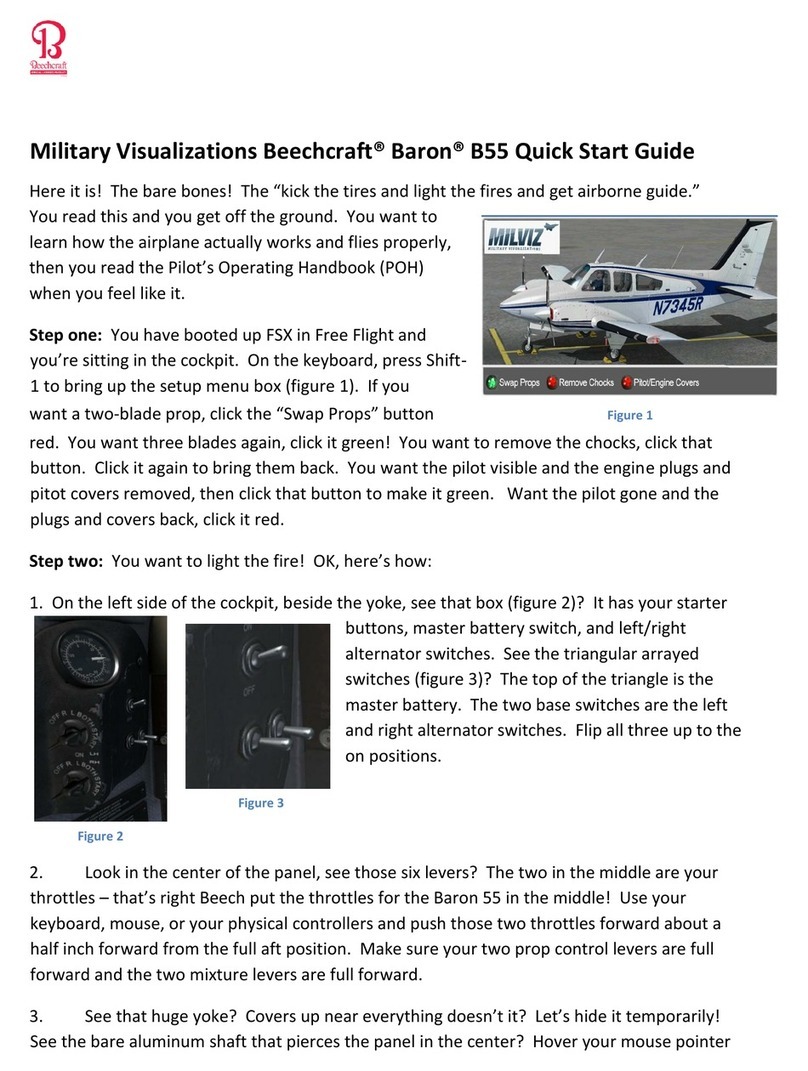
Beechcraft
Beechcraft Baron B55 User manual

Beechcraft
Beechcraft TRAVEL AIR 95 Install guide
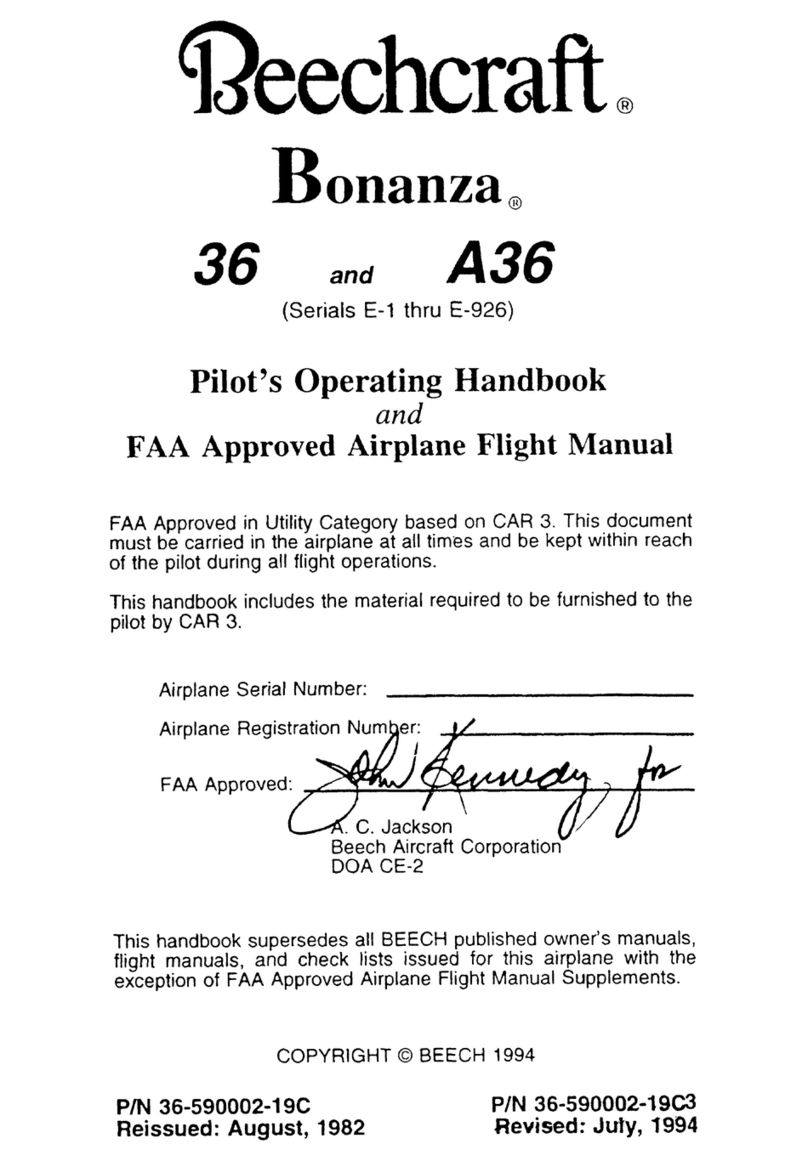
Beechcraft
Beechcraft Bonanza 36 Owner's manual

Beechcraft
Beechcraft Bonanza V35B Owner's manual

Beechcraft
Beechcraft Bonanza V35B-TC User manual
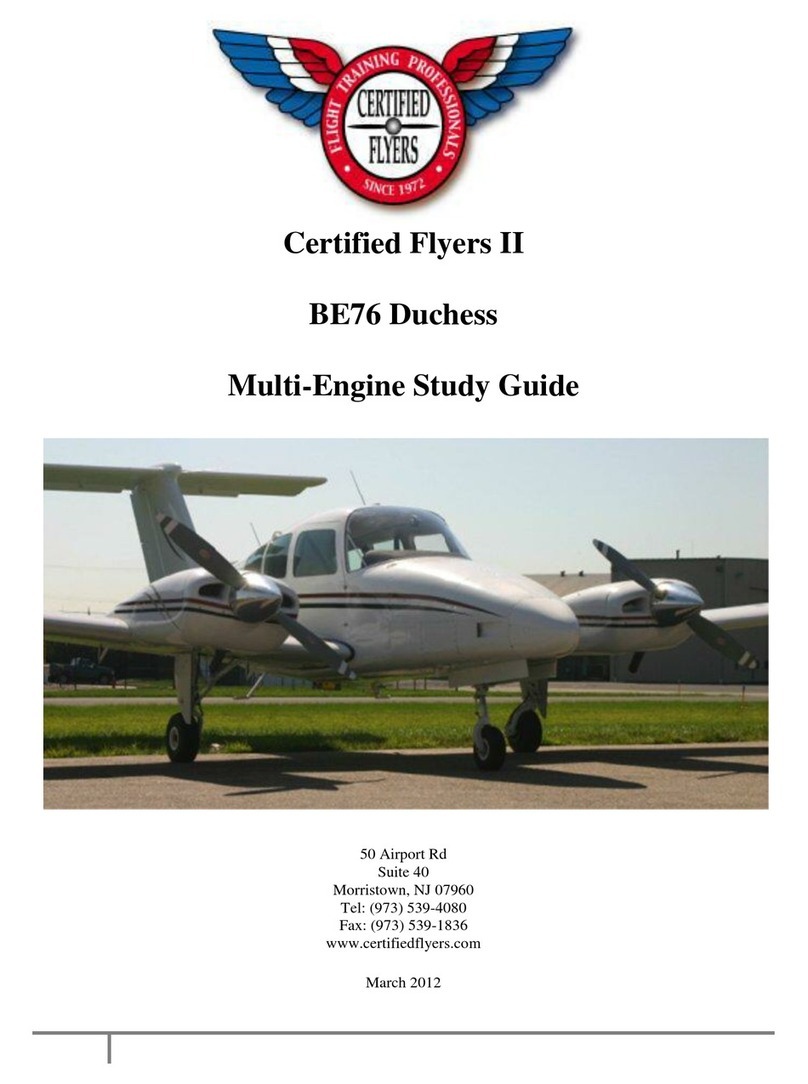
Beechcraft
Beechcraft BE76 Duchess User manual
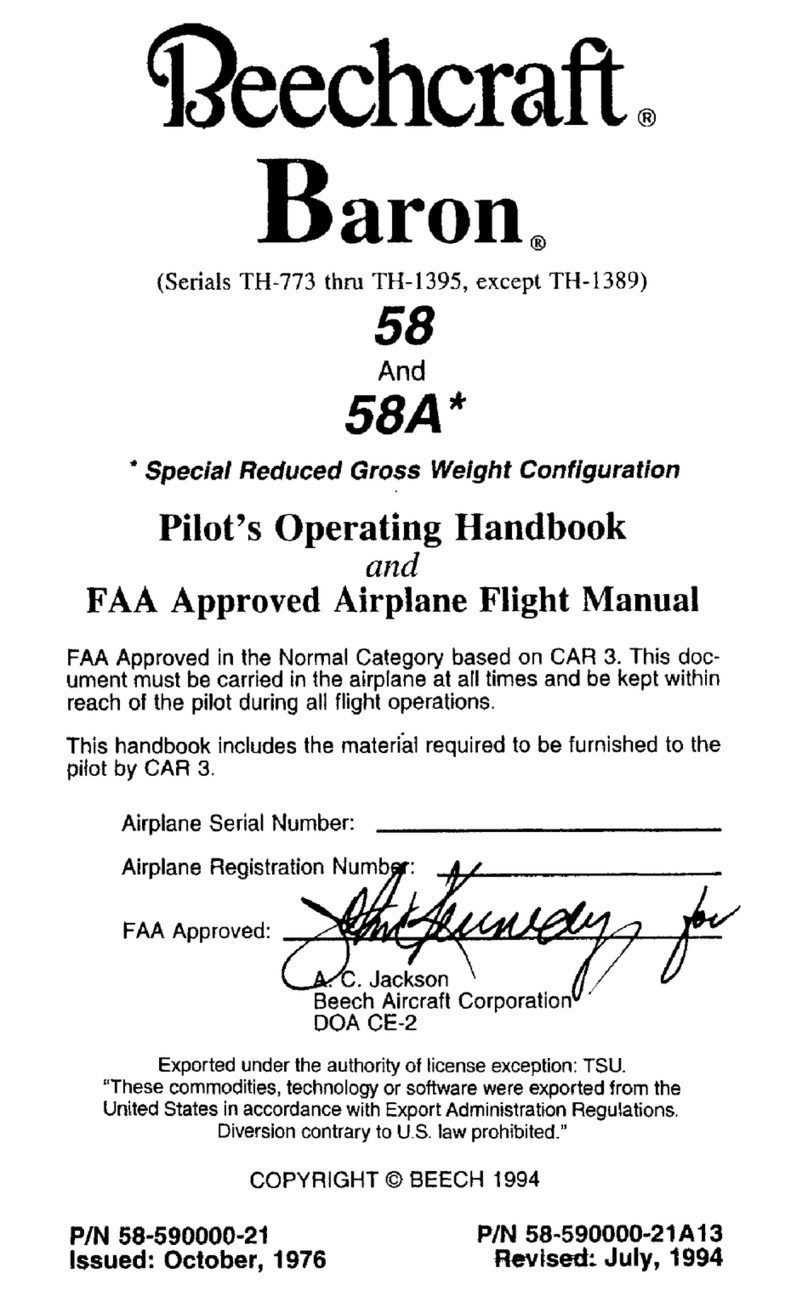
Beechcraft
Beechcraft Baron 58 Owner's manual
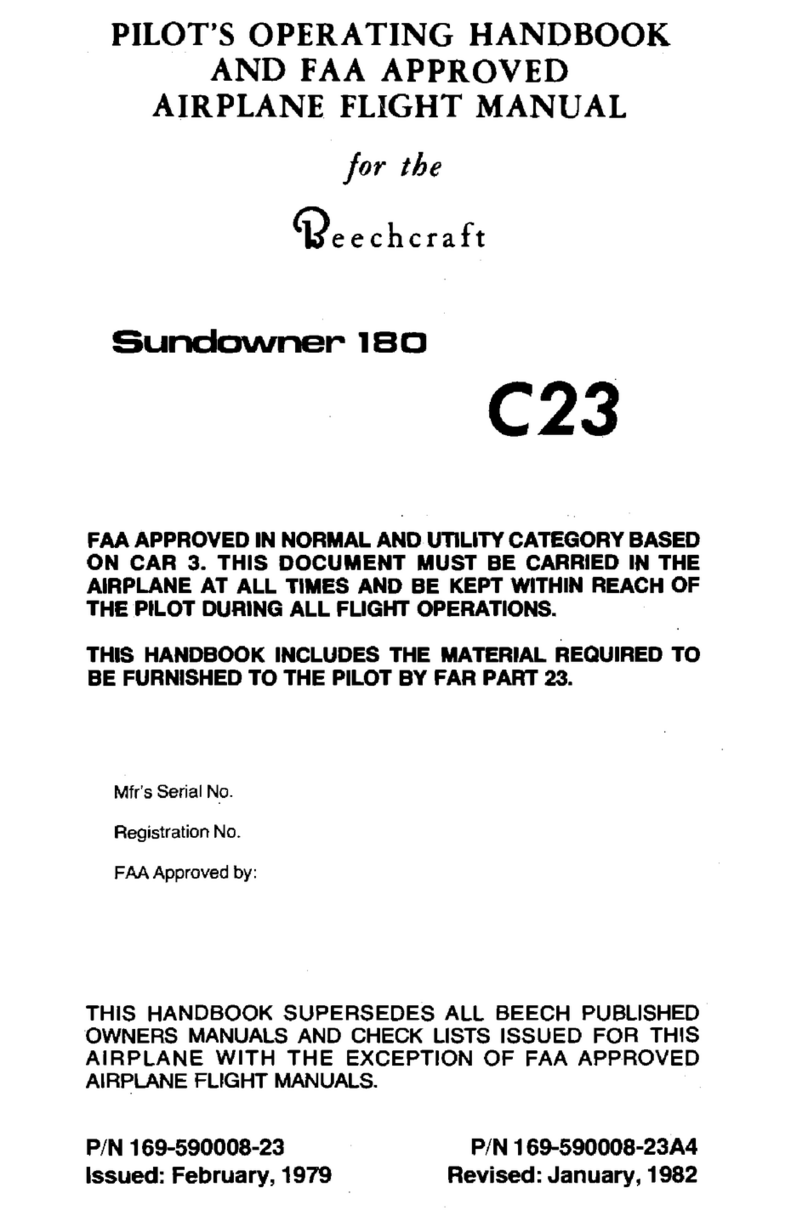
Beechcraft
Beechcraft C23 SUNDOWNER 180 Owner's manual
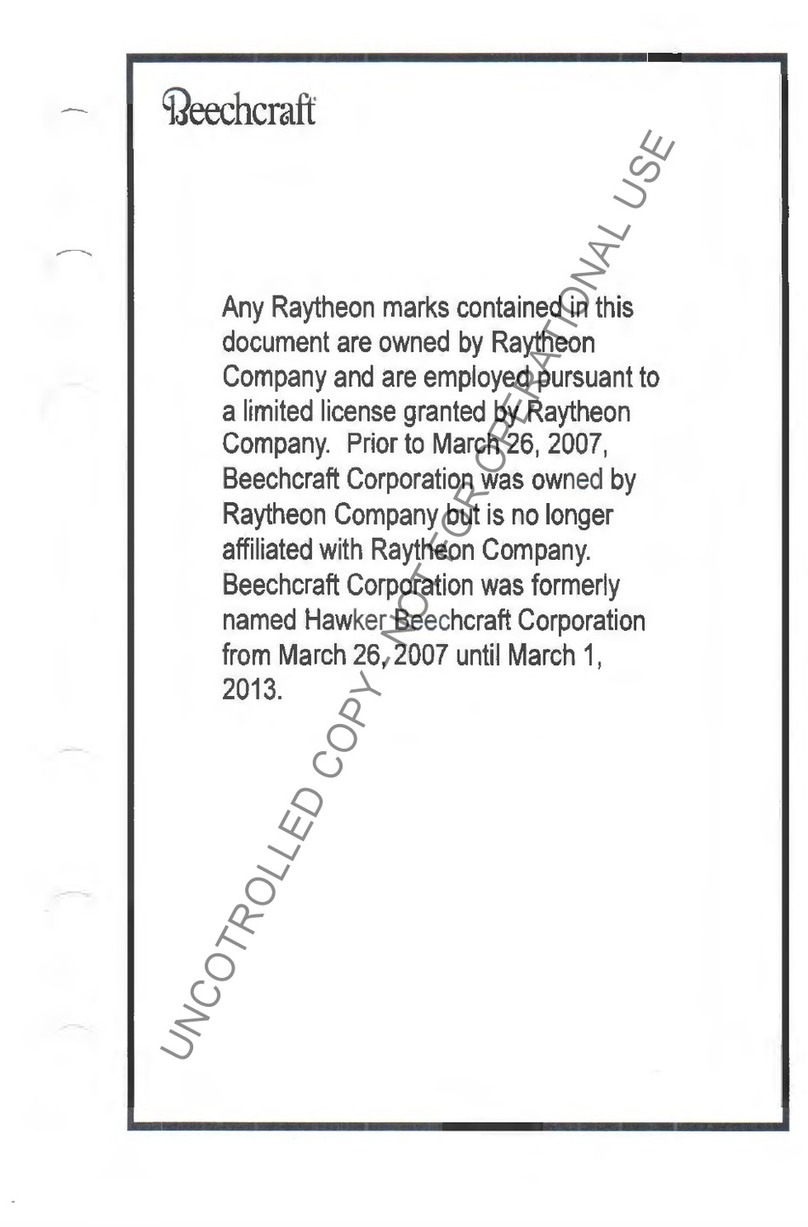
Beechcraft
Beechcraft Musketeer Sport III A23-19 Owner's manual
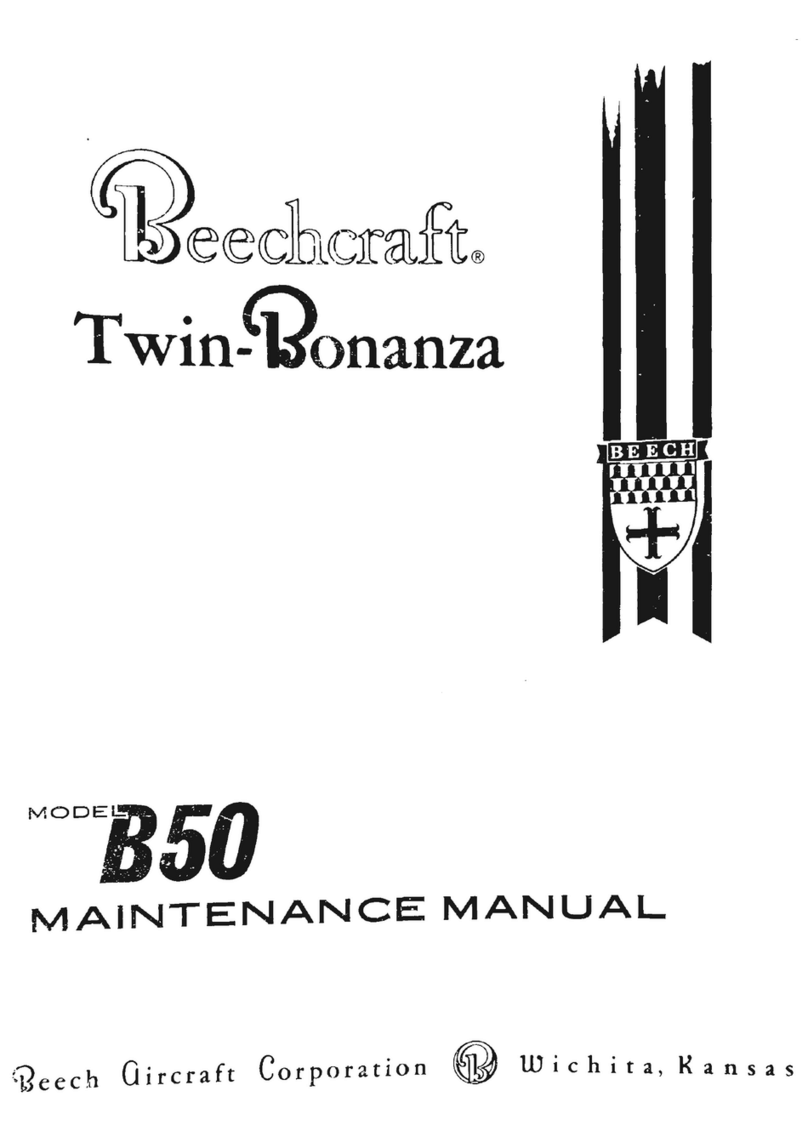
Beechcraft
Beechcraft Twin-Bonanza B50 User manual

